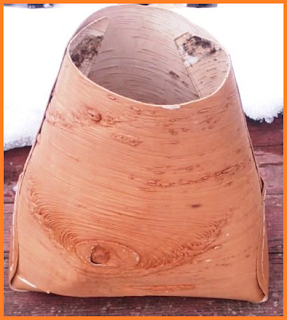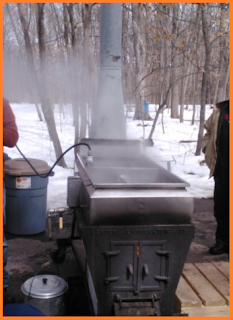There was one slight problem, however...
My daughter didn't find it nearly as awesome as I did. She ran in circles around me, chanting, "I don't wanna do this!" over, and over, and over again. I couldn't pay attention to the men that explained the syrup making process because of this, and I know other people were getting about as annoyed with this situation as I was. She's normally quite well behaved, so this was a rather unique situation.
Fortunately, Zach came to my rescue.
Who is Zach? Why, he's the superhero that told the legend of the origin of maple syrup. His super status arises from his amazing storytelling ability.
Seriously.
The moment he began speaking, my daughter stopped complaining - mid sentence. Her jaw dropped, and she stared up at him, eyes wide.
See? Super powers. And the story was truly fascinating: Zach told us about the Anishinabe legend of maple syrup.
Manabohzo and the Maple Syrup
In the beginning, when maple trees were first created by the Great Spirit, they had thick and sweet syrup running all throughout them. Syrupy goodness all around. No need to work for it.
There was a problem, though.
Since syrup was so easy to attain, everyone began ignoring their work. Rather than hunting and gathering, they'd lay beneath the trees, enjoying the syrup as it leaked from the trees, right into their mouths.
Well, Manabohzo, the great trickster and teacher of humanity, went off to visit his friends the Anishinabe. Unfortunately, he couldn't find them anywhere. Nobody was working the fields, hunting, or crafting necessities. They weren't where they should be.
Finally, he found them laying beneath the trees. He knew this couldn't go on. They'd grow fat and lazy, and that just wouldn't do!
So he got a huge birch bark basket, and dunked it into Lake Superior.
He opened the tops of all the trees, and poured the water inside. He thinned the syrup until it was hardly sweet at all. If the people wanted the sweet syrup the Great Spirit had gifted to them, they'd have to work for it for ever after.
They'd have to place holes in the trees, and use hollowed out twigs to tap them.
The sap would have to be collected in birch baskets over a long period of time.
Rocks would then have to be heated and dropped into the baskets to heat the sap, causing it to thicken and sweeten into syrup.
This would have to be done repeatedly, and would take a great deal of time and work.
Furthermore, the sap would only flow during a time that there was no work to be done: No planting or harvesting, or hunting: A short time of the year at the end of winter and the beginning of spring.
This would teach the people to have appreciation for the gift that the Great Spirit gave to them.
***
In truth, it was difficult to carry and keep syrup, so for the most part, the sap was boiled down until it became granular -
Sugar!
Yum.
Today we use a more modernized approach involving metal taps and bags or buckets that won't leak,
As well as stoves to boil the liquid on.
And yet, it still takes a great deal of time and effort. Manabohzo did a great job of ensuring syrup wasn't taken for granted by those that produce it!










No comments:
Post a Comment